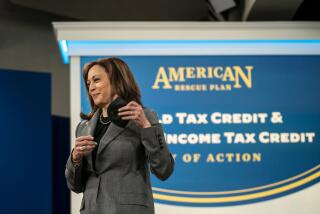Poor Will Get Richer, Impact on Rich Varies : 9 of 10 Low-Income Families Would Gain
WASHINGTON â Congressional tax writers did something this year that has amazed and delighted even critics of the sweeping tax overhaul legislation now headed toward a final vote in Congress--they pulled the teeth from the federal tax bite on the poor.
Their handiwork has not only defanged the income tax for the poor but has provided new money to offset an even sharper Social Security paycheck bite as well. And the scope of that relief has grown steadily as tax overhaul moved from a concept to near-reality.
The result, some experts say, is a tax bill that is also the most important piece of anti-poverty legislation to face Congress during the Reagan Administrationâs six years.
Congressâ Joint Taxation Committee concludes that the tax proposal would cut taxes, on average, by 55% in 1987 and almost 66% in 1988 for households earning less than $10,000 annually. Of the 39 million taxpaying households earning less than $20,000 a year, nearly 9 in 10 would pay less income tax.
The congressional plan offers tax cuts to the middle class and wealthy averaging about 6% of their total income-tax liability. By comparison, some poverty-level families could be eligible for federal tax relief approaching 10% of a householdâs entire annual income.
Ironically, even such comparatively huge tax reductions would merely return millions of low-income households to the light tax burden they enjoyed a decade ago--before galloping inflation and the Social Security solvency crisis ravaged their paychecks. But the benefit to the poor, experts say, remains enormous.
More Than They Hoped
âOne can always imagine things could be better,â said Robert Reischauer, a Brookings Institution scholar and poverty expert. âBut this is far more than I or most of my colleagues hoped that the low-income population would get from tax reform.â
The billâs potential payoff for low-income households is impressive:
--More than 6 million low-income households now paying income taxes would fall below the tax threshold under the new proposal, wiping out their income-tax liability. In 1987, for the first time in roughly six years, no poverty-level family with children would be liable for federal income taxes.
--Millions of other households that are now pushed below the poverty line by federal tax payments would be relieved of most of their burden, allowing them to stay just above the official subsistence level.
--Those families, and still others, would be shielded from inflation and from a relentless increase in Social Security withholding by a strengthened earned income tax credit, a special tax break for poor families with children. In some cases, the beefed-up credit actually would entitle poor families to a check from the Treasury--a negative tax, in effect.
Value Eroded by Inflation
The tax credit, a maximum of $550 this year, was designed to offset the income and payroll tax liabilities of the poorest families, but its value has been severely eroded by inflation since the late 1970s.
Under the congressional compromise, however, the credit would rise to as much as $700 in 1987 and $800 in 1988 and would be adjusted annually for inflation. In addition, the income level at which the credit is fully phased out would rise from $11,000 to $17,000 a year.
The cost to the government would be $13 billion to $15 billion over five years. The number of households eligible for the credit could double to as many as 12 million, said Mary Bourdette, director of government relations for the Childrenâs Defense Fund in Washington. And, she said, the creditâs contribution to those familiesâ standards of living would be profound.
For example, Bourdette estimated that a single parent with two children living at the estimated 1988 poverty line--$9,636 in annual income--would enjoy a tax cut totaling more than $1,100 under the compromise tax overhaul plan (see chart). That is 11.4% of the parentâs total income.
No longer would the family owe $940 in federal taxes--$724 in Social Security taxes and $216 in income taxes--as it would under current law. Instead, it would get $168 back from the government. Its income tax liability would be reduced to zero and its earned income tax credit--in effect, a ânegative tax,â or gift, from Uncle Sam--would exceed its Social Security tax payments.
âInto Their Pocketsâ
âWhile itâs true that it only brings (poverty-level) families back to the late 1970s level of taxation, you canât put down that achievement,â Bourdette said. âThe fact is that a family at the poverty line can save as much as $1,000 on its tax bill, and thatâs a huge amount of cash. Most important, it goes directly into their pockets.
âThe whole bill is great.â
The compromise planâs higher tax threshold and its stronger earned income credit give the most direct relief to low-income households. And those households, like others, are aided by increases in the standard deduction and personal exemption.
Unusually Generous
Single-parent households, many of them living in or close to poverty, would also win an unusually generous increase in the standard deduction for heads of households, from $2,670 under current law to $4,400 as of 1988.
âUnder current law, single households are treated like single people when it comes to the deduction, but now the deduction is moved much closer to the level for married couples,â said Ann Kolker, a policy analyst with the National Womenâs Law Center. âThatâs something we fought for long and hard. About 90% of the single-parent households in this country are headed by women.â
A few economists speculate that low-income families may even take advantage of an aspect of the overhaul plan that many say is regressive--its flat tax rates of 15% and a nominal 28%. They say the low rates and high âbreak pointâ at which the 28% rate takes effect--$29,750 in 1988--may encourage more low-income families to place a second spouse in the work force, because the added income will not be subject to ever-higher taxes.
The benefits of tax overhaul to the poor were neither so obvious nor so heavily promoted until the issue gained political steam this year, lobbyists and congressional aides say. But the need was apparent to the few who kept track of changes in the national tax burden.
Inflation Plays Big Role
The double-digit inflation of the late 1970s played a major role in increasing the taxes of low-income families, pushing their paycheck income into higher tax brackets while eroding the actual value of those checks. But Congress and the White House had a hand in the increase as well.
Congress failed to adjust the earned income credit for inflation throughout the late 1970s and 1980s, weakening its ability to keep families from sinking into poverty. The White House-backed 1981 tax cut largely benefited the middle and upper classes and left the poor untouched. And the Social Security crisis of the early 1980s was resolved by an across-the-board increase in payroll taxes that hit the poor far harder than the well-off.
The White Houseâs 1984 tax overhaul proposal attacked the problem by improving the earned income credit. But tax relief for the poor did not become a potent force until House Democrats sought a share of tax overhaulâs political benefits last fall.
After that, one congressional aide said Tuesday, the scope of relief âgot better in the House, and it was added to in the Senate, and then they improved on that in the conferenceâ of House and Senate bargainers that produced a final package last Saturday.
MAKING THE POOR LESS POOR
The following computations illustrate how the tax bill approved by a House-Senate conference committee last Saturday would affect two hypothetical low-income families. The examples are for 1988, with current law adjusted for expected inflation.
Single-parent family of three with income at poverty line
Current law New law Income $9,636 $9,636 Personal exemptions 3,480 5,850 Standard deduction 2,670 4,400 Taxable income 3,486 0 Income tax liability 383 0 Earned income tax credit 167 892 Total income tax 216 (refund) -892 Social Security tax 724 724 Total federal taxes 940 -168
Two-parent family of four with income at poverty line
Current law New law Income $12,351 $12,351 Personal exemptions 4,640 7,800 Standard deduction 3,950 5,000 Taxable income 3,761 0 Income tax liability 414 0 Earned income tax credit 0 661 Total income tax 414 (refund) -661 Social Security tax 928 928 Total federal taxes 1,342 267
Source: Childrenâs Defense Fund
More to Read
Get the L.A. Times Politics newsletter
Deeply reported insights into legislation, politics and policy from Sacramento, Washington and beyond. In your inbox three times per week.
You may occasionally receive promotional content from the Los Angeles Times.










